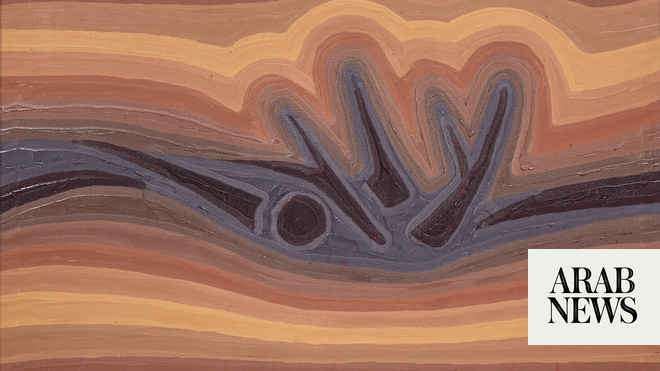
DUBAI: A new exhibition at Sharjah Art Museum in the UAE called “Parallel Histories” showcases 124 artworks from the Barjeel Art Foundation, known for championing Arab art. The show, which runs until spring next year, includes paintings, drawings, sculptures and tapestries. Featuring near-equal representation of female and male artists, some works are being shown for the first time in Sharjah. According to the foundation, the show’s title “references the manifold socio-political events that occurred in the region across the twentieth and twenty-first centuries. While the multiple histories and diverse experiences encapsulated by works on display were often separated by geography, personal circumstance, national borders, political climate, and various conditions of life, they — like parallel lines — often ran alongside one another, replacing each other with time.”
A variety of themes are examined, from political conflict to questions of identity. “We hope that the exhibition will inspire viewers to look at the region’s history with fresh eyes, and question how events of the past have shaped, and continue to shape, our reality today,” curator Suheyla Takesh tells Arab News.
Below, we look at the Saudi artists’ works shown in the exhibition.
Abdulhalim Radwi A key topic explored in the show is “ongoing political strife, including the question of Palestine for example, and Arab solidarity with the ongoing plight of Palestinian people,” Takesh explains. This painting by the late Makkah-born artist, from 1962, features resistance fighters — some of whom are holding slingshots, while others are about to throw rocks. A figure on the left cries, “God is greater.” Radwi was one of the first artists from the Kingdom to receive a grant from the government to study abroad. His other work often incorporated elements of Saudi desert life, architecture, and folklore.
Abdulsattar Al-Mussa During the 1970s, Al-Mussa travelled to Russia to pursue medical studies. But his long-standing interest in the arts meant he changed tack, eventually obtaining an art degree in Moscow, where he took part in his first exhibition. He later moved to Ukraine, where he reportedly made his first mural. Al-Mussa is known for carving everyday scenes onto cardboard, as seen in this solemn black-and-white piece from 1988. According to a statement from Hafez Gallery, he created “drawings of cafés and their employees, as well as the vitality with which they are doing their jobs.” Al-Saleem was born in the northern town of Marat in 1939, and was one of Saudi Arabia’s most prolific artists in the Sixties and Seventies. He was reportedly the first to stage an exhibition in Riyadh (in 1967). As a young man, Al-Saleem was educated by Egyptian tutors, who inspired his interest in calligraphy. Al-Saleem had a deep affinity with the desert. He coined the term ‘horizonism,’ depicting evocative Saudi landscapes that also incorporated abstract Arabic calligraphy.” This 1997 work is a prime example of that style.
Manal AlDowayan AlDowayan’s work often focuses on her fellow countrywomen and the effects on them of the social and cultural transformation the Kingdom has undergone over the past few years. One of her recent motifs is seen in this 2021 work: bent women’s legs. “The Emerging #6” represents “a statement directed at women as they enter the public sphere in Saudi Arabia today,” according to a text published by Art Basel. “In this painting AlDowayan uses the representation of women legs that appear to emerge from the floor. These legs have not fully emerged, just slightly, but they seem ready to kick out to jump through.” Al-Salem is a multidisciplinary artist and architect, who works with neon lights, painting, and sculpture. The written word, especially that pertaining to religion, is at the heart of his practice. “Although you could say my work is very much inspired by my religion, I by no means have a specific audience, and hope that my messages have a spiritual or historical significance for everyone,” he has said. This sculptural work features the title phrase arranged in an abstract form (in Arabic), making the work look like a maze. Tabbaa was born in the mountainous Saudi city of Taif. Like many of his contemporaries, he was inspired by the vast openness and mysticism of the desert. “He employs geometry in composing his three-dimensional work, of which ‘Untitled VII’ is a telling example,” notes Takesh. “Taking the shape of upward arrows on one side, and downward ones on the other side, the work resembles a dynamic architectural element, or a stylized totem pole. Set within a group of architecturally-inspired works at the Sharjah Art Museum, it engages in conversation with paintings that tackle the subjects of geometry and space.”
Alia Ahmad In this 2021 artwork, Ahmad uses muted tones to create a painting that, according to Takesh, “resembles a tapestry or work on fabric, accentuating a possible reading of it as a mirage or illusory scene.” In her artist’s statement, Ahmad writes that she has been “influenced by an upbringing in Riyadh’s industrial/desert landscape. A majority of my paintings represent different placid dreamscapes, with linear impressions of the Saudi landscape.” Takesh adds that Ahmad “weaves together notions of memory, place, and landscape. . . Her work vividly reflects the ephemeral quality of thoughts, visions, and sensations as translated onto a painted surface.”












